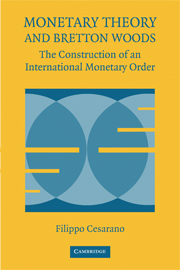Book contents
- Frontmatter
- Contents
- Preface
- Acknowledgments
- 1 INTRODUCTION
- 2 INTERNATIONAL MONETARY EQUILIBRIUM AND THE PROPERTIES OF THE GOLD STANDARD
- 3 THE INTERNATIONAL MONETARY SYSTEM BETWEEN THE WORLD WARS
- 4 THE MONETARY SYSTEM IN ECONOMIC ANALYSIS: THE CRITIQUE OF THE GOLD STANDARD
- 5 THE GREAT DEPRESSION: OVERTURNING THE STATE OF THE ART
- 6 PROVIDING FOR A NEW MONETARY ORDER
- 7 THE BRETTON WOODS AGREEMENTS
- 8 BRETTON WOODS AND AFTER
- References
- Author Index
- Subject Index
Preface
Published online by Cambridge University Press: 18 December 2009
- Frontmatter
- Contents
- Preface
- Acknowledgments
- 1 INTRODUCTION
- 2 INTERNATIONAL MONETARY EQUILIBRIUM AND THE PROPERTIES OF THE GOLD STANDARD
- 3 THE INTERNATIONAL MONETARY SYSTEM BETWEEN THE WORLD WARS
- 4 THE MONETARY SYSTEM IN ECONOMIC ANALYSIS: THE CRITIQUE OF THE GOLD STANDARD
- 5 THE GREAT DEPRESSION: OVERTURNING THE STATE OF THE ART
- 6 PROVIDING FOR A NEW MONETARY ORDER
- 7 THE BRETTON WOODS AGREEMENTS
- 8 BRETTON WOODS AND AFTER
- References
- Author Index
- Subject Index
Summary
Monetary theory has an obvious and recognized role in analyzing monetary systems; it has also been crucial in determining the evolution of those systems. The fulfillment of the issuing function by government, since the early days of coined money, required at least a rudimentary knowledge of the workings of a monetary economy: The state of the art has always influenced the essential features of the monetary mechanism.
The international monetary system introduced at the end of the Second World War is a prime instance of the impact of theory on the institutional framework. The Bretton Woods construction was designed at the drawing board and approved by a formal agreement, and as a consequence the theoretical paradigm was paramount in shaping the new international monetary order. Furthermore, the demise of the short-lived Bretton Woods experience did not just put an end to the postwar monetary reconstruction, but it brought about the generalized diffusion of fiat money, an epoch-making change after 2,500 years of commodity money. These points are closely interrelated, for in the aftermath of the First World War institutions were increasingly influenced by monetary theory, itself developing in response to disruptive shocks. The difficulties of restoring the gold standard stimulated a wide-ranging debate, fueled by the conspicuous imbalances in the major economies and the vicissitudes of the international monetary system. Britain's return to gold in 1925 was followed by most countries, but it proved to be ephemeral.
- Type
- Chapter
- Information
- Monetary Theory and Bretton WoodsThe Construction of an International Monetary Order, pp. ix - xPublisher: Cambridge University PressPrint publication year: 2006

